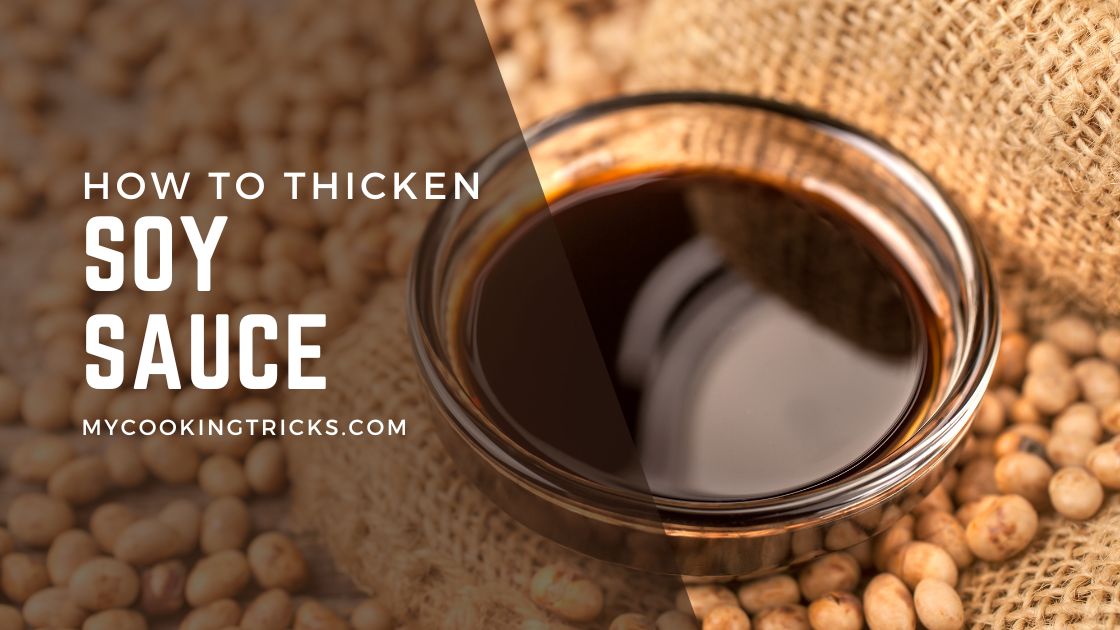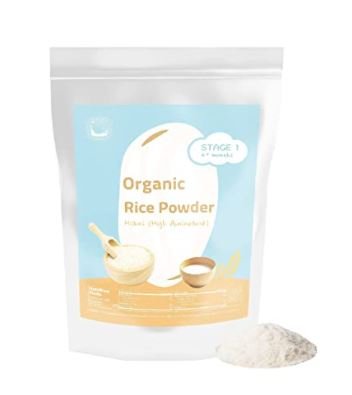Do you know How to Thicken Soy Sauce? Craving for hot and sour soup, stir fry, or a delicious dip? We hear you, but before you can enjoy these and other dishes, all have in common one little but important thing, a delicious soy sauce. Quality soy sauce has a certain level of thickness and if you love it as much as we do, then learning how to make it the right way is a must. The reason why today we’ll be sharing with you everything you need to know about how to thicken soy sauce.
Thicker soy sauce finds use in several recipes, especially when cooking Asian dishes, especially if you’re trying to replicate your favorite takeout. But if your homemade recipe isn’t working for some reason, then you’ve noticed that the thickening struggle is real. If your soy sauce recipe is coming out too thin for whatever reason, do not panic; there’s light at the end of the tunnel.
There are a few different ways you can thicken your homemade soy sauce, so there is no need to throw it away and start all over again. These techniques or methods are actually quite simple; that said, there are important steps you need to keep in mind to transform your soy sauce and give it back its natural and yummy texture and consistency.
How to Thicken Soy Sauce

Method 1: Cornstarch Method
Cornstarch is the default thickener for most people.
Materials:
- 1 to 2 tsp. of cornstarch
- 1 to 2 tsp. of water
- A saucepan
- A bowl
- A spoon
Steps:
- Pour the soy sauce into a saucepan over the low heat
- Create a slurry from the above ratio of cornstarch and water
- Stir the slurry into the soy sauce
- Remove the pan of your sauce from the heat when the thickness reaches the right consistency.
Method 2: Flour Method
This method usually makes a roux, a classic thickening agent consisting of equal parts fat and flour by weight. In most cases, people choose to use butter. Here’s how:
Materials:
- 1 to 2 tsp. of flour
- 1 to 2 tsp. of butter
- A saucepan
- A spoon
Steps:
- Heat butter over medium heat.
- When a sprinkle of flour causes it to bubble, you’re ready to add the rest of your flour.
- Add the remainder of the flour and whisk until your mixture forms a thick paste that is golden brown in color.
- Add roux to your sauce and whisk to combine.
- Test the sauce with a spoon.
Method 3: Flour and Water Method
Materials:
- 1 to 2 tsp. of flour
- 1 to 2 tsp. of water
- A saucepan
- A spoon
Steps:
- Combine two tablespoons flour with every 1/4 cup cold water and whisk until smooth.
- Add the mixture to your sauce over medium heat.
- Continue to stir and cook until you’ve reached your desired consistency.
Method 3: Potato Starch Method
Materials:
- 1 to 2 tsp. of potato starch
- 1 to 2 tsp. of water
- A saucepan
- A bowl
- A spoon
Steps:
- Pour the soy sauce into a saucepan over the low heat
- Create a slurry from the above ratio of potato starch and water
- Stir the slurry into the soy sauce
- Remove the pan of your sauce from the heat when the thickness reaches the right consistency.
Recommended Product
Anthony’s Organic Potato Starch
Made from the best potatoes from Latvia. The potatoes are first checked for quality; then the high-quality potatoes are washed and shredded and then washed again. The potato juice is then separated, the starch is rewashed, and the starch is extracted from the water and completely dried.
It’s a great add-on on hand to save the day for thickening stews, sauces, and meals when they are not the texture you like.
This organic potato starch is gluten-free, making it a great substitute for gluten and grain-filled flours and thickeners.

Features:
- Organic and Vegan
- No Preservatives or Artificial Ingredients
- Paleo Friendly
- Thickening Agent
- Made from 100% Organic Potatoes
- Plant-Based Gluten-Free Flour Alternative
Method 4: Rice Starch Method
Materials:
- 1 to 2 tsp. of rice starch
- 1 to 2 tsp. of water
- A saucepan
- A bowl
- A spoon
Steps:
- Combine equal parts rice starch and cold water.
- Stir together until smooth.
- Pour into your sauce and cook over medium heat.
- Stirring continually until the sauce reaches your desired consistency.
Recommended Product
It is quality rice grown from clear water and fertile soil flowing from Wolchulsan Mountain in Yeongam-gun, Korea, and it is rice that Yeongam-gun guarantees quality.

Features:
- 30% of essential amino acids
Soft and savory taste
Abundant nutrients
Organic
Method 5: Tapioca Powder Method
Materials:
- 1 to 2 tsp. of tapioca powder
- 1 to 2 tsp. of water
- A saucepan
- A bowl
- A spoon
Steps:
- Pour the soy sauce into a saucepan over the low heat
- Create a slurry from the above ratio of tapioca powder starch and water
- Stir the slurry into the soy sauce
- Remove the pan of your sauce from the heat when the thickness reaches the right consistency.
Recommended Product
Tapioca starch is derived from cassava root and can serve as a wheat substitute for conventional flour. Those with restrictive diets, such as those who cannot tolerate wheat or gluten, can use our gluten-free, organic tapioca starch instead.
Make gluten-free bread or flatbreads. Try using our organic tapioca starch as a binding agent or as a thickener. Never worry about gluten or grains when you use tapioca starch.

Features:
- Naturally, gluten-free
- Versatile substitute
- Extracted from Cassava
- Fresh quality
Common Question About How To Thicken Soy Sauce
How do you make soy sauce thicker?
You can thicken soy sauce several ways, the most common being cornstarch, flour, rice starch, or simply making a soy sauce reduction. If using flour or starch, you need to add it to half a cup of cold water, stir it very well, so there are no clumps, then pour the mixture into the soy sauce.
How can I thicken soy sauce without cornstarch?
You may or may not want to add starch to your soy sauce. If this is the case, there are alternative ways to make your soy sauce thicker. You could either opt for a soy sauce reduction, which relies on evaporation to reduce the water quantity of the sauce in the heating process.
Now, this can and will take more time than any other method. Once the sauce starts boiling, you must bring it low, allow it to simmer, and stir it now and then. Follow these simple steps:
- Pour the sauce into a saucepan and put in the stovetop
- Bring the sauce to a boil, then reduce the heat to allow it to keep simmering
- Stir the sauce occasionally until it is thickened as you expect
How do you make the sauce thicker?
If you want to make any sauce thicker, you can utilize cornstarch, flour, rice starch. You can do this with any sauce, be it soy sauce, teriyaki sauce, chili sauce, or just gravy.
What can I use instead of flour to thicken the sauce?
If starch is not your thing and you are also trying to avoid flour, you can always add sugar to your sauce to make it thicker. Just follow the steps below:
What you need:
- Two tsp. of brown sugar
- ¼ cup of water
- A saucepan
- A spoon
Steps:
- Pour the sauce into a saucepan and put in the stovetop
- Add the sugar and water to the sauce
- Stir the sauce frequently until it is thickened as you expect
What are the different methods for thickening sauces?
There are several methods for thickening sauces, including using a roux, cornstarch or flour. A roux is a mixture of fat (usually butter) and flour cooked over low heat until it becomes light brown. Cornstarch and flour can both be added to a sauce to thicken it without cooking. Simply stir in either of these ingredients until the desired consistency is achieved.
Different types of sauces will require different methods of thickening. A roux is best for thicker, creamier sauces, while cornstarch or flour works well for thinner sauces. Experiment with different methods to find the best one for your sauce.
How can I thicken the sauce without flour or cornstarch?
There are a few ways to thicken sauces without flour or cornstarch. One way is to use a roux made from equal parts melted butter and all-purpose flour. Another way is to puree cooked vegetables or fruits and add them to the sauce. A third way is to use uncooked cornstarch mixed with cold water, which is then added to the sauce and simmered until thickened. Finally, arrowroot powder can also be used to thicken sauces without flour or cornstarch.
With so many options available, there’s no need to resort to using flour or cornstarch to thicken your sauces!
Does brown sugar thicken sauce?
Yes, brown sugar can thicken a sauce. It does this by helping to create a thicker syrup and adding more moisture to the sauce. This results in a more prosperous and smoother texture.
Will Honey thicken a sauce?
Honey will thicken a sauce because it is a natural thickener. It contains more sugar than other thickening agents like cornstarch so it can be used in smaller quantities. The downside is that honey also has a strong flavor that can overwhelm other ingredients.
What is thick soy sauce called?
Thick soy sauce is called “kokuso tsuyu” in Japanese. It is a soy sauce made by slowly simmering soy sauce, mirin, and dashi (a type of broth) together. This creates a thicker, more syrupy consistency than regular soy sauce. Kokuso tsuyu is often used as a dipping sauce or to glaze grilled foods.
If you can’t find kokuso tsuyu at your local grocery store, you can make it at home by simmering soy sauce, mirin and dashi together in a pot. Let the mixture simmer for about 30 minutes, or until it has thickened to your desired consistency.
Thick soy sauce is a great way to add flavor to grilled meats or vegetables. Try using it as a dipping sauce for chicken skewers, or brush it on grilled salmon before serving. You can also use it in marinades or stir-fries to boost umami flavor. Give it a try the next time you’re cooking up something delicious!
How much cornstarch do I use to thicken sauce?
You would use one tablespoon of cornstarch to thicken a sauce.
What Dishes Uses Thick Soy Sauce?
Many Asian dishes use thick soy sauce. It is a thicker, more flavorful version of soy sauce that adds flavor to dishes like stir-fry, fried rice, and noodles. If you want to add more flavor to your Asian dishes, then you should try thick soy sauce. Here are some of our favorite dishes that use thick soy sauce:
- Stir-Fried Noodles with Vegetables: This dish is packed with flavor thanks to the addition of thick soy sauce. The noodles are stir-fried with various vegetables, and the thick soy sauce gives them a delicious umami flavor.
- Fried Rice with Chicken: This dish is another great way to use thick soy sauce. The rice is fried with chicken and vegetables, and the thick soy sauce adds an extra layer of flavor.
- Thai Chicken Curry: This dish is a delicious, hearty curry that gets its flavor from thick soy sauce. The chicken is cooked in a curry paste and coconut milk, and the thick soy sauce adds depth of flavor.
If you are looking for a way to add more flavor to your Asian dishes, then give thick soy sauce a try.
Additional Tips on How to Thicken Soy Sauce
- If using flour or starch, you need to add it to half a cup of cold water, stir it very well so there are no clumps, then pour the mixture into the soy sauce. Heat and simmer until it reaches the consistency you want.
- You’ve probably noticed your commercial soy sauce will almost always find it in its regular, thin form. This is because often, you’ll find hydrolyzed soy sauce.
- Remember that once your soy sauce reduces, it will be much more robust in flavor since it won’t be diluted in as much water. This may be good or bad, depending on what you like from your soy sauce.
- Honey can be used to replace brown sugar as its consistency can help to thicken the sauce. Stir a small amount of honey at a time until the sauce is at the right thickness.
- Make sure to pour the mixture of water and cornstarch into the sauce gradually, a little bit at once, to avoid turning the sauce too thick.
- Real, aged soy sauce will be a little bit thicker. Getting thick soy sauce only happens if you get very well-aged bottles.


